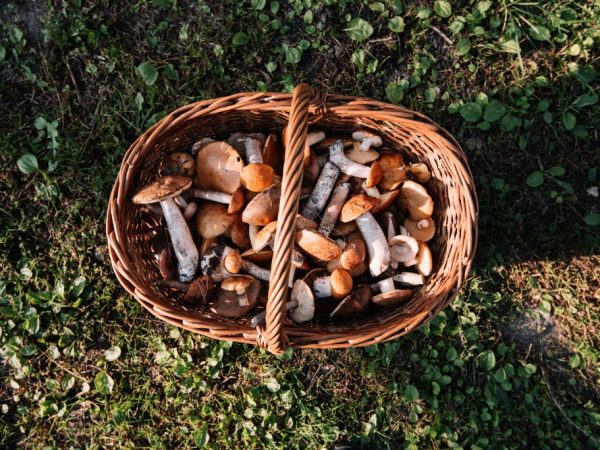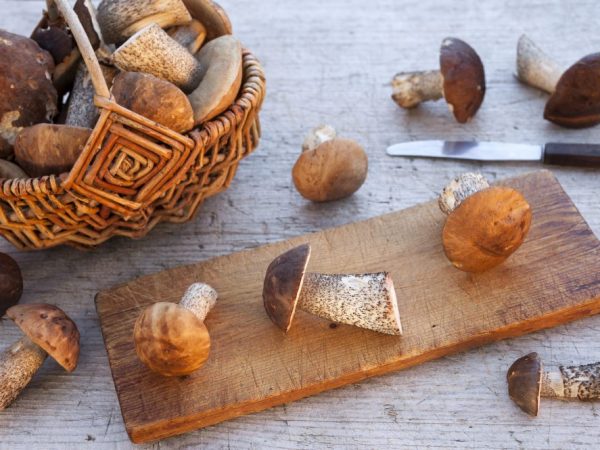What mushrooms grow in June
Although summer is not considered a full-fledged mushroom season, it is useful to know which mushrooms grow in June. Many mushroom pickers in a short time can harvest a crop that is not inferior in diversity to the autumn one.

What mushrooms grow in June
Where and when to pick mushrooms
June mushrooms are harvested at the beginning to the middle of the month. Places of collection - light, heated areas from the edge of forests. It is worth looking on the hills and small glades. Some species bear fruit for only 5-10 days.
It is important to observe the weather and take into account that:
- a lot of mushrooms will appear if the weather was warm and rainy;
- mushroom "wave" ends with the arrival of heat.
Some species are found in forests all summer and autumn. True, in dry hot weather, there are much less of them than in rainy autumn.
Types of summer mushrooms
In early June, a porcini mushroom, a blushing fly agaric, russula, boletus, chanterelles, tinder fungus, honey mushrooms appear. In some places, mushrooms are found, but rarely.
In late May and early June, the May mushroom appears. It is found in meadows, pastures. Harvesting is carried out from late April to early July. It is a bright white fleshy mushroom with a pulp smell reminiscent of fresh flour. The hat is cream-colored, then turns white.
A variety of porcini mushroom - white mushroom - "spikelet" - is found in oak forests on clay soil, as well as in mixed forests on soil with an abundant sand content. He lives only a decade, so you should hurry to find him.
The first mushrooms in June can be represented only by red mushrooms. It is important to distinguish edible from true species, i.e. poisonous fly agaric. The panther fly agaric is especially similar to it:
- Worms often live in edibles, flies land on it.
- The smell of the edible species is unappetizing, and the poisonous pulp smells like radish.
- When a representative of a non-poisonous fly agaric species breaks down, the pulp changes color over time.
Irina Selyutina (Biologist):
Amanita muscaria, which is also called gray-pink, or pink, has a cap that reaches 4-10 cm in diameter. It is gray-pink, with small grayish, white, brownish or even dirty pink remnants of the common bedspread. The pulp turns red at the cut site. It is on this basis that pink fly agaric differs well from red and panther. The plates of the hymenophore are free, white, slightly reddening at maturity. Leg tuberously widened downwards, white, then reddish; the ring under the cap (the remains of a private bedspread) is white and also turns red later. The vagina (volva) is represented by flakes arranged in rows and quickly disappearing.
This type of fly agaric forms mycorrhiza with various representatives of deciduous and coniferous tree species, giving preference to birch and pine.
Forest gifts can be dangerous, poisoning is fatal, so if there is any doubt about the edibility of the fruit body, it is better to leave it in place.
Russula appear among birches. They are easy to find on moss or in the shade of trees. Russula, like moss and honey agarics, will be found in the forests throughout the summer.
Summer mushrooms grow in groups on stumps in deciduous forests, less often in conifers.The collection of these species is also carried out carefully: after all, next to the edible specimens, there are false mushrooms and among them the gallery is bordered. Signs that distinguish it from the edible species:
- she has a uniform cap color;
- there is a white bloom on the leg under the cap.
Therefore, when collecting summer mushrooms, it is important not to forget that they are not found in coniferous forests - a bordered gallery usually grows there, which settles on heavily rotted coniferous wood.

Early boletus
In the middle of the month, the first boletus mushrooms appear at this time. They are also found at the end of May. At the beginning of the summer month, they temporarily disappear, but then appear.
Almost all summer they are looking for "Duboviks". Until the middle of the month, sulfur-yellow tinder fungi actively grow.
Some mushrooms are available for harvesting throughout June-July. So, chanterelles grow on moss, they are harvested until October.
In the forests and in the glades, they collect redheads (aspen), boletus, wild boletus, and bitter. The latter species is very likely to be found everywhere: it is unpretentious to soil, moisture, lighting. It grows in both coniferous and deciduous forests, ends the season with the first cold weather.
The milky juice of the bitter has the smell of freshly sawn wood. On the cut, it is actively released, the pulp does not darken when it comes into contact with air.
At this time, it is important to beware of the pale toadstools, which begin to appear in late June or early July.
Correct processing
You cannot pick mushrooms near roads, chemical and industrial plants, private houses, farms.
The mycelium (the underground vegetative body of fungi) actively feeds on what enters the soil. Even edible species grown in a polluted environment cannot be used for food. Also, you cannot pick mushrooms, the type of which is unknown to the mushroom picker.
At the first signs of poisoning, they call an ambulance and while they are waiting for it, they begin to carry out urgent detoxification of the body using available means. At the same time, you need to try to preserve the remnants of the mushroom dish that became the culprit of the problem. This is extremely important because will greatly facilitate the identification of the type of mushrooms and, accordingly, the type of toxin that caused the poisoning for the specialists of the medical laboratory.
Rules for processing forest mushrooms:
- Sort them by size and type, remove dirt and forest debris from them.
- Cut off rotten or too soft parts, suspicious areas. In some species, the skin is removed from the cap and the stem is removed.
- Rinse forest mushrooms under running water several times. Collect the washed and boil in boiling salted water for 5-7 minutes.
- Drain the broth, rinse the mushrooms again and cook for another 30 minutes in salted water.
In the case of mushroom preparation, not for conservation, but for further drying, they are not washed, only debris is removed.
Boiled for food and canning. It will not be superfluous to boil for further frying. Unused fruiting bodies are stored in the refrigerator, frozen for the winter. Homemade preparations are eaten throughout the year.
Conclusion
Mushroom picking in June is suitable for experienced mushroom pickers and for those who want to feast on fresh forest products. The first species in June are porcini mushrooms, reddening fly agarics, chanterelles, honey agarics, boletus mushrooms, tinder fungi, oak trees, bitter.
Mushrooms can be picked in June in the forest, in the glades. They should not be collected near roads, businesses, private houses. All collected trophies must be sorted and boiled. They are not washed to dry.



